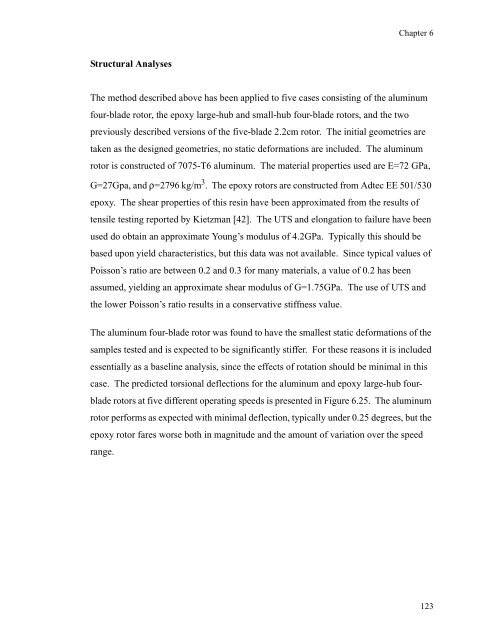Aerodynamics and Design for Ultra-Low Reynolds Number Flight
Aerodynamics and Design for Ultra-Low Reynolds Number Flight
Aerodynamics and Design for Ultra-Low Reynolds Number Flight
You also want an ePaper? Increase the reach of your titles
YUMPU automatically turns print PDFs into web optimized ePapers that Google loves.
Structural Analyses<br />
Chapter 6<br />
The method described above has been applied to five cases consisting of the aluminum<br />
four-blade rotor, the epoxy large-hub <strong>and</strong> small-hub four-blade rotors, <strong>and</strong> the two<br />
previously described versions of the five-blade 2.2cm rotor. The initial geometries are<br />
taken as the designed geometries, no static de<strong>for</strong>mations are included. The aluminum<br />
rotor is constructed of 7075-T6 aluminum. The material properties used are E=72 GPa,<br />
G=27Gpa, <strong>and</strong> ρ=2796 kg/m 3 . The epoxy rotors are constructed from Adtec EE 501/530<br />
epoxy. The shear properties of this resin have been approximated from the results of<br />
tensile testing reported by Kietzman [42]. The UTS <strong>and</strong> elongation to failure have been<br />
used do obtain an approximate Young’s modulus of 4.2GPa. Typically this should be<br />
based upon yield characteristics, but this data was not available. Since typical values of<br />
Poisson’s ratio are between 0.2 <strong>and</strong> 0.3 <strong>for</strong> many materials, a value of 0.2 has been<br />
assumed, yielding an approximate shear modulus of G=1.75GPa. The use of UTS <strong>and</strong><br />
the lower Poisson’s ratio results in a conservative stiffness value.<br />
The aluminum four-blade rotor was found to have the smallest static de<strong>for</strong>mations of the<br />
samples tested <strong>and</strong> is expected to be significantly stiffer. For these reasons it is included<br />
essentially as a baseline analysis, since the effects of rotation should be minimal in this<br />
case. The predicted torsional deflections <strong>for</strong> the aluminum <strong>and</strong> epoxy large-hub four-<br />
blade rotors at five different operating speeds is presented in Figure 6.25. The aluminum<br />
rotor per<strong>for</strong>ms as expected with minimal deflection, typically under 0.25 degrees, but the<br />
epoxy rotor fares worse both in magnitude <strong>and</strong> the amount of variation over the speed<br />
range.<br />
123




